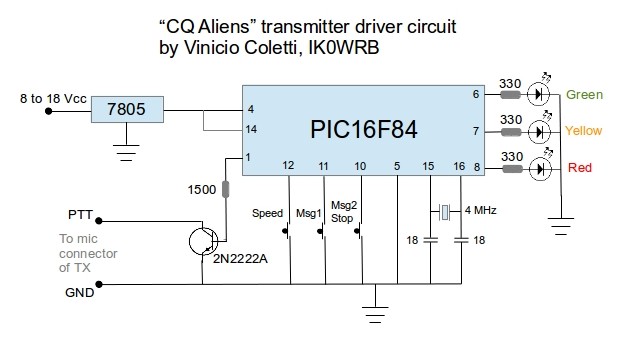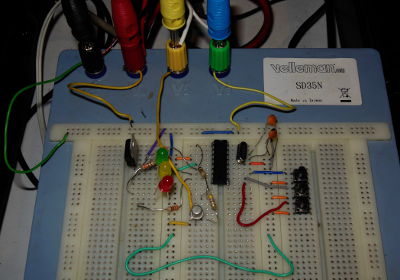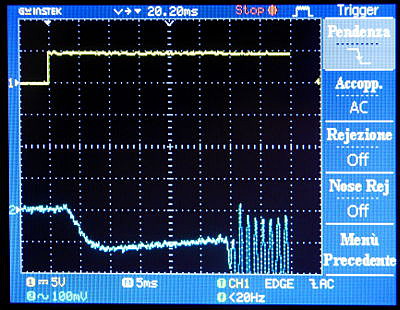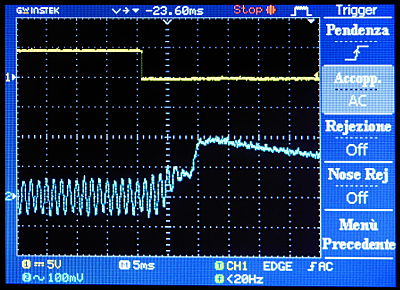Vinicio Coletti, IK0WRB
CQ Aliens
Introduction
The known universe is made by a huge number of galaxy clusters, each one composed by smaller clusters,
each one with many galaxies inside. Each galaxy is then composed by a big number of stars. For example our own galaxy,
the Milky Way, is estimated to contain about 100 billion stars, or 1011 stars, if you like.
Until some decades ago, there was no direct evidence that other stars, different from our Sun, hosted a planetary system.
Since all stars, like babies, are born with the same basic system, it was logical to think that many other stars had planets
around them, but this was a mere hypothesis.
Then astronomers began to use new methods and this way many new planets have been discovered, proving at last that the solar
system is not an exception, but it is quite normal, compared to the rest of the universe. As of the end of 2014, over one
thousand planets have been discovered! Most of these planets are bigger than Earth or very close to their star, because
the methodology used is sensitive mainly to the gravitational effect of the planet on the star. Thus, it is logical to think
that planets are even more common than now observed and that th ere are many smaller planets out there.
By the way all these arguments lead us to wonder whether life is present somewhere outside Earth. Again, there is still no
evidence of life, but since the chemical and biological mechani sms look similar everywhere, it looks logical to presume
that on many planets there is life and also, on some of them, intelligent life.
And what about a contact with them? Radio looks the ideal instrument to communicate at great distances, even stellar distances,
but of course we must take into account the limits that physics laws impose. With a signal speed limited to the speed of
light, we can expect to exchange messages only with civilizations placed at most at some dozen light years of distance.
Or we can simply listen (like SETI Institute does) hoping to catch an intelligent signal coming from very far away.
Even the simple reception of such a signal, with no practical way to reply, would have a great impact on our culture
and will profoundly change the way we look at everything.
Well, we can do also a third thing, that is send radio signals around, like messages in a bottle, in the hope that
other civilizations will get them and will direct their attention towards our planet. It they are not so distant,
they could even reply or decide to send a probe to the solar system. In fact we are already behaving this way without knowing,
since it is about 90 years that we transmit regular and strong radio and tv signals.
Summary
This project is about transmitting radio signals, designed to be easily understood by another civilization. Although
more powerful transmitters and bigger antennas would be needed, I think than even an individual like me can try
to send such emissions. Who knows what could happen in the future? And in any case, it will be amusing.
My signals will be transmitted only on radio amateur bands, because I cannot transmit elsewhere, and, from a legal point of view,
they will be radio amateur beacon emissions. In fact, radio amateurs can listen to these signals and even send me
a reception report, if they like. At the beginning and end of every transmission there will be my callsign in CW.
I have designed for now two different messages, described later in this page, that will be transmitted at three different
speeds: 1 second, 10 seconds or 1 minute per unit. Slower messages have a greater possibility to be detected at very
low signal levels.
Design choices
There are of course many things to decide: what frequency? What power? What antenna? At what times and
how often?
Some of this decisions are mandatory for now, until I will ch ange my setup, but still they are meaningful. For example,
many SETI-like searches are done in VHF and UHF bands, or even in SHF. With these bands one can use a relatively small
antenna having big gain and high directivity.
But, the higher the frequency, the higher the signal loss (for the same distance),
so I decided to use, at last at the beginning of this project, the frequency of 29 MHz. Although in the 10m band,
it is a frequency rarely used by radio amateurs. Also, transmitting in winter and during the night, the possibile interference
(propagation) by the ionosphere will be minimized.
As antenna I will use a tuned windom, that works from the 80m band up. Thus, not a directional emission, but
covering roughly a celestial hemisphere. Big loss of signal, but wider coverage and no need to aim to or track some point.
To transmit I will use my Kenwood TS590S, driven by a circuit designed by myself and assembled on a prototyping board, plus
an Ameritron AL-811H amplifier, with a carrier of 500 Watt.
The circuit
The circuit to drive the transmitter is based on a Microchip PIC16F84 microcontroller and is made by a small number of components. Here you can see the electrical circuit.

When the circuit is switched on, the green led lights.
Pressing the SPEED button you can change the time base, cycling through 1 second, 10 seconds and 1 minute. The yellow led
flashes 1, 2 or 3 times to inform you about the current selec ted time base.
Pressing the MSG1 button will start the transmitting sequence of message 1, which is: two times the IK0WRB/B callsign at about
20 wpm, separated by 1 second of pause, then message 1 at the current selected speed, then finally the IK0WRB/B callsign.
During the actual message transmission the yellow led lights steadily and the red led goes on and off following the state
of the transmitter carrier.
Pressing MSG2 button will start a similar sequence, only it is message 2 that it is transmitted.
MSG2 button acts also as STOP button: pressing it at any moment during the transmission, will abort it. Only the final callsign
will be transmitted anyway, then transmission will end.

Since my messages rely on pulse duration, I decided to test the circuit with my radio to see how much delay was present when
switching on and off the transmitter. I found that the ON delay is about 30 ms and the OFF delay is about 5 ms. This means
that the ON periods lose 25 ms and the OFF periods gain the same, 25 ms. I thus modified the program to take into account this
delays, adding 25 ms to every ON period and subtracting the same time from OFF periods.
Here you can see the time measures as they looked like on my oscilloscope. Track 1 is on pin 1 of the PIC, track 2 is the audio
taken from a radio receiver tuned to have a 1 kHz audio from the transmitter carrier.


Message 1
The two messages I have designed so far are very simple, nevertheless carrying a lot of useful information.
Message 1 transmits the integer numbers, from 1 to 10, with a pause of 1 second between every number. Numbers are
transmitted as carrier periods having a length that is an integer multiple of the pause period. To make things simple,
what is transmitted is the following:
- Carrier 1 second
- Pause 1 second
- Carrier 2 seconds
- Pause 1 second
- Carrier 3 seconds
- Pause 1 second
- Carrier 4 seconds
- Pause 1 second
- Carrier 5 seconds
- Pause 1 second
- Carrier 6 seconds
- Pause 1 second
- Carrier 7 seconds
- Pause 1 second
- Carrier 8 seconds
- Pause 1 second
- Carrier 9 seconds
- Pause 1 second
- Carrier 10 seconds
- Hey, this comes from intelligent beings! Because it is unlikely that a natural process could produce such a signal
- The unit of time on this planet is 1 second, that is the pause period and also the integer divisor of every carrier period
- "Probably" we use a numeric system with base 10, because 10 numbers were transmitted (not 11 or 7 or ...)
The slower speed, having a base of 1 minute, will send information about another time unit we use: the minute, by the way.
Message 2
Message 2 follows the same schema of message 1, but instead of transmitting the sequence of the integer numbers
from 1 to 10, it will transmit the first 10 prime numbers: 2, 3, 5, 7, 11, 13, 17, 19, 23, 29.
This sequence will inform that not only we are intelligent, but we know something about mathematics :-)
More seriously, this sequence will make even more certain that the origin is an intelligent life form, wishing to
send information about itself.
Meta information
Other useful information may be carried not by the messages but by the way they are repeated. For example sending the same sequence at exactly 23 hours and 56 minutes (about) will inform about the duration of Earth rotation, whilst repeating at 24 hours of distance, will inform about the mean solar day.
Next messages
I have no other messages ready, but I am planning a way to send in a simple way other data about Earth:
the composition of solar system, the mass of the planets, the composition of earth atmosphere, etc.
Then, if someone working on exobiology wish to send these messages, and next ones, from a facility like Arecibo or even smaller :-),
I will be pleased to collaborate with him/her! It would be a dream to see similar messages send to space...
Contacts
For any problems related to this project, write to: <mycallsign> AT tiscali.it
Please put the string "cqaliens" somewhere in the message subject.

To do
There are still many little things to do in this project.
- Find a list of closer stars (I have already something)
- Compute which closer stars are over the horizon at every transmission time
- Compute the signal level at every likely distance (of course it will be very very tiny...)
February 5, 2016 update
So far, I have decided to suspend real transmission of signals, which would be better done at sites having
the right power and antenna size. I will focus instead on other transmission contents.
From now on, I will not show the pause in every message, that will be always be constant inside it and equal to 1 second or
10 seconds or 1 minute or even more, 1 hour for example. Thus I will simply show the sequence of CARRIER ON times, measured
towards the base time (pause or OFF time).
By the way for a specific base time and a specific message, we must compute if the target star will be over the horizon
during the whole transmission time. This will be always true for stars whose declination is greater that local latitude (for
southern hemisphere: lower than local latitude).
So let's list the seven messages I have figured out so far.
Natural numbers
The first 10 natural numbers, showing this is an artificial message and that our number system is decimal.
Sequence: 1, 2, 3, 4, 5, 6, 7, 8, 9, 10
Prime numbers
The first 10 prime numbers, to show that our civilization knows something about numbers.
Sequence: 2, 3, 5, 7, 11, 13, 17, 19, 23, 29
Planet orbits
This sequence will give some information about our star system. It will list the mean radius of
the orbits of all main eight planets of the solar system. Each value will not be expressed in meters nor in km nor in any other
arbitrary unit, but using as unit the Earth mean orbital radius. This value is used very often in astronomy and it is
called "Astronomical Unit" (AU). The orbits will be listed in order of distance from the Sun, starting with Mercury
and ending with Neptune.
All this will have two important effects on the alien listeners. First of all they will see a sequence of values becoming larger and larger,
so it would be easy to imagine that this could be a list of orbits, going from the internal to the external one.
Then, they will see that the third value is exactly one, leading them to imagine that the signal is coming from the third planet
or our system.
Please note that with this message I introduce "fractional signals", that is signal times that are not an integer multiple of the pause
time. Some of these times will even be shorter, even much shorter, than the pause signals. If transmitted first, these messages could
confuse listeners, but if we transmit first the two "integer" messages of natural and prime numbers, the meaning of this message
should be quite clear for any intelligent civilitazion able to receive such signals.
Sequence: 0.4, 0.7, 1, 1.6, 5.2, 9.5, 19.6, 30
Planet mass
This sequence should be transmitted after planet orbits and conveys the mass of every planet in the solar system. Since it
has eight values as the latter, it should be natural to match both sequences. Thus if the first was about the orbits, this could
be about how massive each planet is.
By the way also this sequence will be fractional and it will take the mass of Earth as unit, so that the third value will be 1.
A problem here could be the range of these values, that go from a mere 0.06 for Mercury to a huge circa 318 for Jupiter. Thus some
signals could become really long to transmit, but this is the simpler way to send this kind of information.
Sequence: 0.06, 0.82, 1, 0.11, 317.89, 95.18, 14.54, 17.15
Earth atmosphere
Here I will transmit as fifth message the composition of Earth athmosphere. By the way it will be a rounded up
sequence, where I will show only the main 3 components of the air: Nitrogen, Oxigen and Argon. Also, since argon takes only
less than 1%, we should also round up even more, giving only N and O percentages.
The main problem here is not the percentage value, since aliens should be already familiar with fractional messages (n. 3 and n. 4),
but the way to communicate atoms and molecules. I think the easier way is to send the atomic number to express an atom and a list
of atomic numbers for molecules. Thus, for nitrogen, since its atomic number is 7 and the gas is made by a biatomic molecule (N2),
this will be simply sent as the sequence 7, 7.
The same will apply to oxigen, where the atomic number is 8 and the gas is also made by a biatomic molecule (O2). So the sequence
will be 8, 8. For argon, the molecule is made by only one atom, so the single value 18 will be sent.
After each molecule a fractional value will express its percentage. it is important that all fractional values add up to 1, so
that it will be clear that they are percentages.
Sequence: 7, 7, 0.78, 8, 8, 0.21, 18, 0.01
Simplified sequence: 7, 7, 0.79, 8, 8, 0.21
Earth composition
For this message I will use the same method used for the atmosphere, only listing here not molecules but atoms.
So every substance will be listed as an atomic number followed by its percentage. The list is quite long, but if we make it shorter,
the rounding would be too high.
I have found on Wikipedia, the composition of Earth, whose main eight components are the following: Iron (32%), Oxigen (30%), Silicon (15%),
Magnesium (14%), Sulfur (3%), Nickel (2%), Calcium (2%), Aluminum (2%). All values are rounded.
Sequence: 26, 0.32, 8, 0.3, 14, 0.15, 12, 0.14, 16, 0.03, 28, 0.02, 20, 0.02, 13, 0.02
Water presence
Although the water is counterintuitively very rare on the Earth's crust, it is very important to human life and to life in general.
It is also quite present and visible on the surface (oceans, lakes, rivers, ice caps, snow, clouds...) so the seventh message tells
simply that water is present and is very important to us, without sending any quantitative values.
Thus this will be a very short sequence, showing only the composition of the water molecule: 1 atom of Oxigen ad 2 of Hydrogen,
sent as atomic numbers, just as before.
Sequence: 8, 1, 1